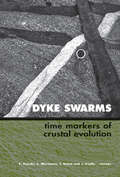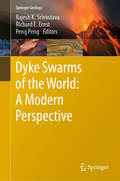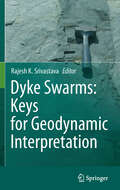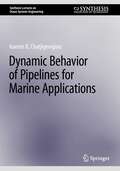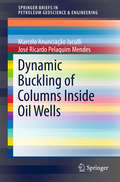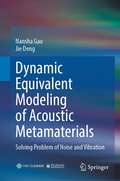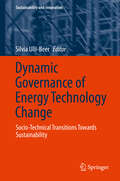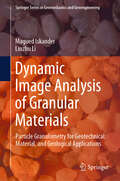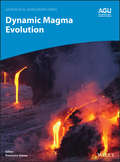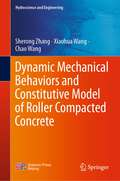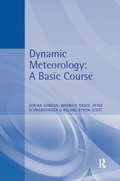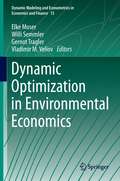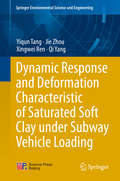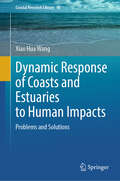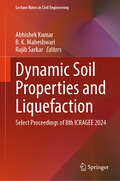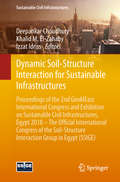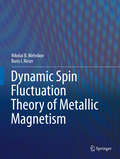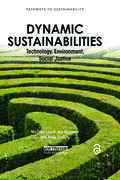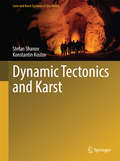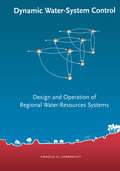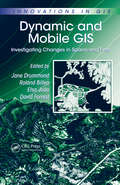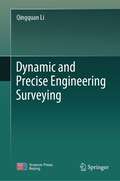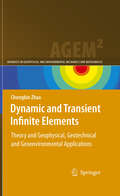- Table View
- List View
Dyke Swarms - Time Markers of Crustal Evolution: Selected Papers of the Fifth International Dyke Conference in Finland, Rovaniemi, Finland, 31 July- 3 Aug 2005 & Fourth International Dyke Conference, Kwazulu-Natal, South Africa 26-29 June 2001
by E. Hanski S. Mertanen T. Rämö J. VuolloDyke swarms are remnants of large igneous provinces, and are pointers of continental break-up events, as well as indicators for ancient continental reconstructions. These global geodynamic aspects are of crucial significance in tectonics, and with recent developments in high-precision age, dating it has become possible to enter these short-lived ma
Dyke Swarms of the World: A Modern Perspective (Springer Geology)
by Richard E. Ernst Rajesh K. Srivastava Peng PengContinuing the tradition of International Dyke Conference, this book is largely based on contributions from the IDC7 but also includes some chapters by invitation. It focuses on mafic dyke swarms and related associations: e.g. links with sills, kimberlites, syenites, carbonatites, and volcanics, discussing the following themes: (i) regional maps/reviews of dyke swarms and related units, (ii) the role of giant dyke swarms in the reconstruction of supercontinents/paleocontinents, (iii) mapping of dykes using remote sensing techniques, (iv) geochronology of dyke swarms, (v) petrology, geochemistry and petrogenesis of dykes, (vi) emplacement mechanism of dykes, (vii) dyke swarms and planetary bodies, and (viii) links to mineralization and resources.
Dyke Swarms: Keys for Geodynamic Interpretation
by Rajesh SrivastavaDykes occur in a wide variety of geological and tectonic settings and their detailed study through space and time is imperative for understanding several geological events. Dykes are believed to be an integral part of continental rifting and when they occur as spatially extensive swarms of adequate size, they can be of immense utility in continental reconstructions and also help to identify Large Igneous Provinces (LIPs). It is known that continental flood basalts and major dyke swarms have their origin related in some way to the up-rise of hot mantle plumes which may lead to rifting and eventual continental break-up. Dykes signify crustal extension and are important indicators of crustal stabilisation events, supercontinental assembly and dispersal, crust-mantle interaction and play a significant role in the delineation of crustal provinces as well as in deciphering crustal evolution events. Many economic mineral deposits of the world are also associated with a variety of dykes. The volume will provide state-of-the-art information on all aspects of dykes with emphasis on the origin, evolution and emplacement of dykes.
Dynamic Behavior of Pipelines for Marine Applications (Synthesis Lectures on Ocean Systems Engineering)
by Ioannis K. ChatjigeorgiouThe dynamic behavior of pipelines describes the time-varying continuous response of these structures under extreme effects, that are generated by the surrounding environment (waves and sea currents) and motions imposed by the host floating facility. This book describes all known impacts that affect the behavior and operation of a pipeline conveying an inner flow for underwater applications. "Known Impacts" are those phenomena that are considered important according to practice and experience. Underwater pipelines are typical, unique structures that are attached to unique floating facilities. The design and utilization of underwater pipelines depend strongly on the installation site and the intended application's particulars. It is possible that future technology demands will require us to cope with additional challenges that will be considered important for the design and operation of underwater pipelines, leading inevitably to the enhancement of the "known challenges".
Dynamic Buckling of Columns Inside Oil Wells (SpringerBriefs in Petroleum Geoscience & Engineering)
by Marcelo Anunciação Jaculli José Ricardo Pelaquim MendesThis book introduces the underlying concepts of column dynamics and buckling, based on the latest state-of-the-art research on this innovative topic. It begins with a summary of the basic concepts behind column dynamics and buckling, before moving on to the models for studying dynamic buckling inside oil wells. Four models with increasing complexity are presented: columns without friction; columns with friction; columns inside slant wells; and columns inside offshore wells. Each model is divided into two cases, depending on whether the column is being tripped in or out. A case study is used to demonstrate these models and is further developed as each model is presented and explained. The results include comparisons between the models themselves, thus showing the implications of the adopted hypotheses of each. This book enables academic, industrial, and graduate student readers to fully understand the fundamentals of dynamic buckling and to further develop the presented models for their own research.
Dynamic Earth
by Prentice HallThis book contains everything teenagers need learn about the earth. Topics covered in this book are: earthquakes, volcanoes, earth's crust, plate tectonics, rocks, minerals, weathering, soil formation, erosion and deposition
Dynamic Equivalent Modeling of Acoustic Metamaterials: Solving Problem of Noise and Vibration
by Nansha Gao Jie DengThis book derives physical models from basic principles, studies the effect of equivalent models on the dynamic characteristics of phononic crystals and acoustic metamaterials, and analyzes the physical mechanisms behind vibration and noise reduction. It first summarizes the research status of vibration and noise reduction, and research progress in phononic crystals and acoustic metamaterials. Based on this, one-dimensional periodic beam, two-dimensional thin plate with circular hole, and corresponding gradient structures are introduced, and their dynamic characteristics are discussed in detail. Therefore, different equivalent methods for different models are proposed through theoretical analysis, modal analysis and transmission rate analysis. Finally, a Helmholtz-type acoustic metamaterial, i.e. a multi-layer slotted tube acoustic metamaterial, is studied. Aiming at the low-frequency band gap of this model, a theoretical model for solving the inverse problem of acousto-electric analogue equivalent is proposed, and the effect of structural parameters on the low-frequency band gap is studied using this equivalent model. This book closely revolves around how to conduct equivalent research on artificially fabricated periodic structures. The methods and conclusions presented in this book provide a new theoretical basis for the application of artificial woven periodic structures in the field of low-frequency vibration reduction and noise reduction and are also an innovation in the discipline of vibration and noise control. This book is suitable for undergraduate students, graduate students and teachers in vibration and noise majors in universities, and can also provide references for engineering and technical personnel in related fields.
Dynamic Fluidic Sprinkler and Intelligent Sprinkler Irrigation Technologies (Smart Agriculture #3)
by Junping Liu Xingye Zhu Alexander Fordjour Shouqi YuanThis book presents a newly designed dynamic fluidic sprinkler (DFS) to improve hydraulic performance of the existing complete fluidic sprinkler (CFS) under low-pressure conditions. Sprinkler irrigation has high prospects for improving water management in crop production. In recent years, low-pressure water-saving has become an important research content in the field of sprinkler irrigation. It introduces the effect of riser height on rotation uniformity and application rate of the dynamic fluidic sprinkler. It also discusses the intelligent sprinkler irrigation technologies for autonomous and remote sensing system. This book will be a useful reference for researchers and professionals in the field of agriculture and irrigation.
Dynamic Governance of Energy Technology Change
by Silvia Ulli-BeerFormulating effective responses to the global challenges of mitigating climate change and securing a sustainable energy future requires a clear understanding of the interdependent causalities between institutions, local decision making, strategic alliances and eco-innovations, as well as policies. It has been acknowledged that the linear "Manhattan project" model is not an adequate governance model for mastering the dynamic complexity of socio-technical transitions; therefore this book aims at advancing research on systematic transition management models. It offers qualitative and quantitative analyses of socio-technical transitions in road transportation and housing, bringing together tailored theorizing on sustainability transitions and applied system dynamics modeling. It highlights the interconnected causal feedbacks that are required to overcome the lock-in situation in road transportation and housing fueled by fossil energies. Showing which concerted actions and framework conditions are required in the transition phases in order to initiate and sustain socio-technical transition, it serves as a guide to model-based strategy making, policy design and analyses in support of sustainable futures.
Dynamic Image Analysis of Granular Materials: Particle Granulometry for Geotechnical, Material, and Geological Applications (Springer Series in Geomechanics and Geoengineering)
by Magued Iskander Linzhu LiThis book explores the effectiveness of Dynamic Image Analysis (DIA) in granulometry studies of sand, and presents criteria for soil characterization using DIA, including test parameters, specimen size, efficacy in gap-graded soils, and its limitations. DIA is a modern experimental technique used to analyze and classify particulate materials based on their size, shape, and other morphological properties. This method employs a high-frame-rate camera to capture images of individual sand particles, which have been transported and separated using various techniques. DIA generates both particle size and shape information by analyzing thousands to millions of particles, providing a quantitative statistical description of grain size and shape distribution within the specimen. The manuscript also offers a comprehensive examination of 2D and 3D particle size and shape descriptors. It demonstrates that there is no correlation between size and shape parameters in many sands and that shape descriptors can be reduced to four independent parameters representing sand granulometry at different scales. Additionally, the use of DIA in exploring the depositional history of two complex calcareous sands is presented. The manuscript presents the properties of 30 representative sands, including size and shape parameters, and fits them to statistical distributions. The investigated soils encompass both natural and machine-sorted materials, particles with regular and irregular shapes, as well as siliceous and calcareous sands. Physical granulometry of sand particles is compared using 2D, 3D DIA, and micro-computed tomography (μCT). The work demonstrates that DIA offers significant advantages in terms of efficiency for 3D shape analysis while providing an adequate representation of particle sizes and shapes of most sands. Finally, the manuscript integrates classical geotechnical engineering with computer vision and artificial intelligence. Size and shape descriptors are utilized for sand classification through machine learning models. This work represents a crucial step toward the automatic machine classification of soils, potentially enabling on-site classification using smartphones equipped with high-resolution cameras.
Dynamic Magma Evolution (Geophysical Monograph Series)
by Francesco VetereExplores the complex physico-chemical processes involved in active volcanism and dynamic magmatism Understanding the magmatic processes responsible for the chemical and textural signatures of volcanic products and igneous rocks is crucial for monitoring, forecasting, and mitigating the impacts of volcanic activity. Dynamic Magma Evolution is a compilation of recent geochemical, petrological, physical, and thermodynamic studies. It combines field research, experimental results, theoretical approaches, unconventional and novel techniques, and computational modeling to present the latest developments in the field. Volume highlights include: Crystallization and degassing processes in magmatic environments Bubble and mineral nucleation and growth induced by cooling and decompression Kinetic processes during magma ascent to the surface Magma mixing, mingling, and recharge dynamics Geo-speedometer measurement of volcanic events Changes in magma rheology induced by mineral and volatile content The American Geophysical Union promotes discovery in Earth and space science for the benefit of humanity. Its publications disseminate scientific knowledge and provide resources for researchers, students, and professionals.
Dynamic Mechanical Behaviors and Constitutive Model of Roller Compacted Concrete (Hydroscience and Engineering)
by Chao Wang Sherong Zhang Xiaohua WangThis book systematically illustrates the dynamic mechanical behaviors and discusses the fundamentals of the constitutive modeling of roller-compacted concrete (RCC), influenced by the construction technique and mix design. Four typical problems are analyzed using laboratory tests, numerical simulation and theoretical analysis, i.e., to illustrate the special dynamic mechanical behaviors of RCC, to reveal the dynamic size-dependence of mechanical properties, to discuss the aggregate size effect on dynamic mechanical properties, and to modify the dynamic constitutive model for RCC. Generally, the constitutive modeling of RCC needs a comprehensive understanding of dynamic size-dependence and aggregate size effect of concrete that coupled with the strain-rate sensitivity. So that, readers can master the modified dynamic constitutive model of RCC to analyze and solve the problems in blast-resistance analysis and protective design of RCC dams.This book can be used as a postgraduate textbook for civil and hydraulic engineering in colleges and universities, and as an elective course for senior undergraduates. It can also be used as a reference for relevant professional scientific researchers and engineers in field of protective design of concrete structures.
Dynamic Meteorology: A Basic Course
by Adrian Gordon Warwick Grace Roland Byron-Scott Peter Schwerdtfeger'Dynamic Meteorology: A Basic Course' is an introduction to the physics of the atmosphere. Starting from the basics, it provides students with an awareness of simple mathematics and enthusiastically proceeds to provide a thorough grounding in the fundamentals of meteorology. The authors lead students to a scientifically rigorous understanding of the behaviour of weather systems such as highs, lows, fronts, jet streams and tropical cyclones. From the 'ABC' of the laws of Avogrado, Boyle and Charles to the powerful omega equation and beyond, this is a simple exposition of dynamic meteorology. Why does the wind blow along the lines of isobars rather than across them? Why are low pressure systems on the weather map more intense than high-pressure systems? Why is there much less constraint on the strength of the wind around a cyclone than an anticyclone? An international team of academic experts in meteorology answer these and many other fundamental questions with simple mathematical equations. Covering both northern and southern hemispheres, 'Dynamic Meteorology' equips students of earth and environmental sciences with proper understanding of the essential mathematics necessary to unlock the mysteries of the natural world.
Dynamic Optimization in Environmental Economics
by Willi Semmler Elke Moser Gernot Tragler Vladimir M. VeliovThe book presents new developments in the dynamic modeling and optimization methods in environmental economics and provides a huge range of applications dealing with the economics of natural resources, the impacts of climate change and of environmental pollution, and respective policy measures. The interrelationship between economic activities and environmental quality, the development of cleaner technologies, the switch from fossil to renewable resources and the proper use of policy instruments play an important role along the path towards a sustainable future. Biological, physical and economic processes are naturally involved in the subject, and postulate the main modelling, simulation and decision-making tools: the methods of dynamic optimization and dynamic games.
Dynamic Response and Deformation Characteristic of Saturated Soft Clay under Subway Vehicle Loading
by Yiqun Tang Jie Zhou Xingwei Ren Qi YangInvolving several areas of geological engineering, geotechnical engineering and tunnel engineering, this book describes the soft soil deformation characteristics and dynamic responses induced by subway vibration load. Based on field monitoring and laboratory testing data, with both comprehensive micro-and macroanalysis, the authors present dynamic characteristics and deformation settlement of saturated soft clay surrounding subway tunnels using dynamic and static methodology. Mechanism of deformation, failure in microstructure of soft clay soil, dynamic response, macro deformation and settlement are all discussed and analyzed thoroughly and systematically. Some of the research findings in this book have been widely applied by large subway companies and will have broader application prospects in future. All the above make this book a valuable reference not only for technical engineers working in subway design or construction but also for advanced graduate students. Prof. Yiqun Tang works at the Department of Geotechnical Engineering, Tongji University, Shanghai, China.
Dynamic Response of Coasts and Estuaries to Human Impacts: Problems and Solutions (Coastal Research Library #40)
by Xiao Hua WangThe coasts cover a diverse range of ecosystems within marine, estuarine, and freshwater environments. They are some of the most heavily populated and visited areas and are also some of the most threatened natural habitats. Coastal zones are critically important not only to the people who live there but for the health of the planet. Many world estuaries and coast environments are under tremendous stress in response to global warming and the increased anthropogenic forcing. Warmer waters, rising sea levels, tropical cyclones, storm surges and flooding, and coastal erosion are just some of the elements impacting coastal communities worldwide and transforming these environments. Coastal hazards such as storm events with associated storm surges are increasing in frequency and intensity, as are marine heatwaves that devastate coral reefs. Human activities like sewage discharge, overfishing, navigation channel dredging, land reclamation, the construction of shipping ports and marine plastics are also responsible for coastal pollution and degradation. Therefore, a good understanding of the current state of coastal environments and lessons learnt from these human influences is extremely valuable to restore and protect these habitats and ecosystems from further environmental degradation and even catastrophe. In this book, case studies are used to tell a story about how these environments respond to severe human-induced perturbations, and what has gone right and wrong from environmental and resource management point of view. The readership of the book include high level undergraduate Oceanography students and workers from Coastal Engineering and Management.
Dynamic Soil Properties and Liquefaction: Select Proceedings of 8th ICRAGEE 2024 (Lecture Notes in Civil Engineering #569)
by Abhishek Kumar Rajib Sarkar B. K. MaheshwariThis book will present the select proceedings of the 8th International Conference on Recent Advances in Geotechnical Earthquake Engineering and Soil Dynamics (8ICRAGEE) held at the Indian Institute of Technology (IIT), Guwahati between December 11 and 14, 2024. It contains the latest research papers covering the contributions and accomplishments in geotechnical earthquake engineering and soil dynamics in the last four years. The five volumes of the book cover a wide range of topics, including but not limited to seismic hazard analysis, wave propagation and site characterization, dynamic properties and liquefaction of soils, pile foundations, offshore foundations, seismic design of retaining structures and dams, seismic slope stability and landslides, dynamic soil-structure interaction, seismic design of structures. Further, recent developments on these topics are covered in different chapters. This book will be valuable not only for researchers and professionals but also for drawing an agenda for future courses of action from the perspective of geotechnical earthquake engineering, keeping the national need at the forefront.This book will present the select proceedings of the 8th International Conference on Recent Advances in Geotechnical Earthquake Engineering and Soil Dynamics (8ICRAGEE) held at the Indian Institute of Technology (IIT), Guwahati between December 11 and 14, 2024. It contains the latest research papers covering the contributions and accomplishments in geotechnical earthquake engineering and soil dynamics in the last four years. The five volumes of the book cover a wide range of topics, including but not limited to seismic hazard analysis, wave propagation and site characterization, dynamic properties and liquefaction of soils, pile foundations, offshore foundations, seismic design of retaining structures and dams, seismic slope stability and landslides, dynamic soil-structure interaction, seismic design of structures. Further, recent developments on these topics are covered in different chapters. This book will be valuable not only for researchers and professionals but also for drawing an agenda for future courses of action from the perspective of geotechnical earthquake engineering, keeping the national need at the forefront.
Dynamic Soil-Structure Interaction for Sustainable Infrastructures: Proceedings of the 2nd GeoMEast International Congress and Exhibition on Sustainable Civil Infrastructures, Egypt 2018 – The Official International Congress of the Soil-Structure Interaction Group in Egypt (SSIGE) (Sustainable Civil Infrastructures)
by Deepankar Choudhury Khalid M. El-Zahaby Izzat IdrissThis volume focuses on the role of soil-structure-interaction and soil dynamics. It discusses case studies as well as physical and numerical models of geo-structures. It covers: Soil-Structure-Interaction under static and dynamic loads, dynamic behavior of soils, and soil liquefaction. It is hoped that this volume will contribute to further advance the state-of-the-art for the next generation infrastructure as a key to creating a sustainable community affecting our future well-being as well as the economic climate. The volume is based on the best contributions to the 2nd GeoMEast International Congress and Exhibition on Sustainable Civil Infrastructures, Egypt 2018 – The official international congress of the Soil-Structure Interaction Group in Egypt (SSIGE).
Dynamic Spin-Fluctuation Theory of Metallic Magnetism
by Nikolai B. Melnikov Boris I. ReserThis book presents a theoretical framework for magnetism in ferromagnetic metals and alloys at finite temperatures. The objective of the book is twofold. First, it gives a detailed presentation of the dynamic spin-fluctuation theory that takes into account both local and long-wave spin fluctuations with any frequency. The authors provide a detailed explanation of the fundamental role of quantum spin fluctuations in the mechanism of metallic magnetism and illustrate the theory with concrete examples. The second objective of the book is to give an accurate and self-contained presentation of many-body techniques such as the functional integral method and Green's functions, via a number of worked examples. These computational methods are of great use to solid state physicists working in a range of specialties.The book is intended primarily for researchers, but can also be used as textbook. The introductory chapters offer clear and complete derivations of the fundamentals, which makes the presentation self-contained. The main text is followed by a number of well-organized appendices that contain a detailed presentation of the necessary many-body techniques and computational methods. The book also includes a list of symbols and detailed index. This volume will be of interest to a wide range of physicists interested in magnetism and solid state physics in general, both theoreticians and experimentalists.
Dynamic Sustainabilities: "Technology, Environment, Social Justice"
by Ian Scoones Melissa Leach Andrew Charles StirlingLinking environmental sustainability with poverty reduction and social justice, and making science and technology work for the poor, have become central practical, political and moral challenges of our times. These must be met in a world of rapid, interconnected change in environments, societies and economies, and globalised, fragmented governance arrangements. Yet despite growing international attention and investment, policy attempts often fail. Why is this, and what can be done about it? How might we understand and address emergent threats from epidemic disease, or the challenges of water scarcity in dryland India? In the context of climate change, how might seed systems help African farmers meet their needs, and how might appropriate energy strategies be developed? This book lays out a new 'pathways approach' to address sustainability challenges such as these in today's dynamic world. Through an appreciation of dynamics, complexity, uncertainty, differing narratives and the values-based aims of sustainability, the pathways approach allows us to see how some approaches are dominant, even though they do not produce the desired results, and how to create successful alternative 'pathways' of responding to the challenges we face. As well as offering new ways of thinking about sustainability, the book also suggests a series of practical ways forward - in tools and methods, forms of political engagement, and styles of knowledge-making and communication. Throughout the book, the practicalities of the pathways approach are illustrated using four case studies: water in dryland India, agricultural seeds in Africa, responses to epidemic disease and energy systems/climate change. Published in association with the Economic and Social Research Council (ESRC)
Dynamic Tectonics and Karst
by Stefan Shanov Konstantin KostovThe karstic caves are favorable sites for tectonic events detecting, representing a conservative medium of three-dimensional framework where the tectonic deformations are well preserved. They also provide an environment conducive to dating and determining the geometrical parameters of past seismotectonic events. During the last three decades the study of dynamic tectonics and recent geodynamics in karst terrains has been subject of numerous publications, but it has not been systematically approached in a comprehensive monograph. This book collects the current state of knowledge on the relationship between karst and dynamic tectonics and presents a new methodology to its study. It puts forward several approaches for studying of recent geodynamics in karst terrains, such as tectonic stress fields reconstructions using structural analysis of the fracturing, geophysical studies of the rock anisotropy and fault-plane solutions from earthquakes, analysis of the spatial orientation and absolute dating of deformed speleothems, instrumental and mechanical measurements, monitoring and modeling - all supported with case studies from several karst areas worldwide, e. g. in Albania, Bulgaria, Cuba and France.
Dynamic Water-System Control
by A.H. LobbrechtTypically a large number of interests with conflicting requirements are involved in the management of a water system. The computer-based method of management introduced in this text - dynamic control - is designed to determine the most effective operational strategy.
Dynamic and Mobile GIS: Investigating Changes in Space and Time (Innovations in GIS)
by David Forrest Elsa Joao Roland Billen Jane DrummondWith the widespread use of PDAs, wireless internet, Internet-based GIS, and 3G and 4G telecommunications, the technology supporting mobile GIS is rapidly gaining popularity and effectiveness. Dynamic and Mobile GIS: Investigating Changes in Space and Time addresses Web GIS, mobile GIS, and the modeling, processing, and representation of dynamic eve
Dynamic and Precise Engineering Surveying
by Qingquan LiDriven by the increasingly expanding needs of infrastructure construction, operation and maintenance, as well as the rapid developments of intelligent sensing and information technology, precise engineering surveying has been transformed from static, discrete, and manual into dynamic, continuous, and intelligent ways. This transformation leads to an advanced multidisciplinary field, dynamic and precise engineering surveying, on which the author has worked for over two decades. This book systematically summarizes the fundamentals, methods, and applications in dynamic and precise engineering surveying. The contents mainly include two parts: the first part introduces principles and methods of dynamic and precise engineering surveying; the second part presents representative applications in which innovative methods and advanced equipment are applied in the construction, operation and maintenance of mega and complex infrastructures.Readers engaged in surveying and mapping, civil engineering, water conservancy engineering, railway engineering, electronic information, and computer science, including undergraduates, graduates, researchers and engineers, will find it an informative reference.
Dynamic and Transient Infinite Elements
by Chongbin ZhaoThis monograph aims to provide a state-of-the-art theory and the application of dynamic and transient infinite elements for simulating the far fields of infinite domains involved in many of scientific and engineering problems, based on the author's own work during the last two decades. While the theoretical aspects of either dynamic infinite elements or transient infinite elements are systematically presented, the related application examples are immediately followed to illustrate the usefulness and applicability of these infinite elements for simulating a wide range of dynamic and transient problems involving infinite domains. To broaden the readership of this monograph, common mathematical notations are used to derive the formulations of both dynamic and transient infinite elements. This enables this monograph to be used either as a useful textbook for postgraduate students or as a valuable reference book for computational geoscientists, geotechnical engineers, civil engineers, geoscientists and applied mathematicians.
